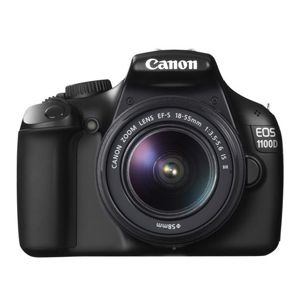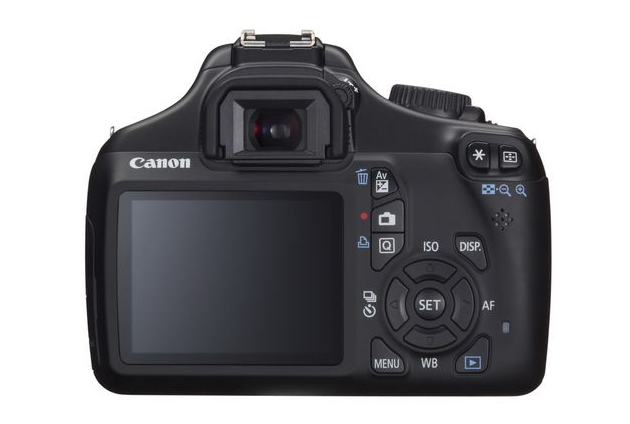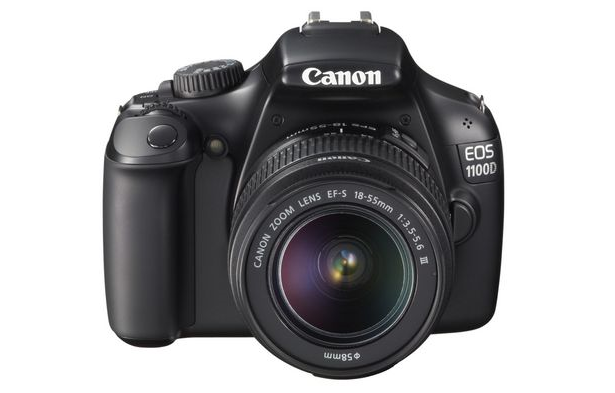The Canon EOS 1100D follows on from the previous 1000D model. It’s been quite a few years in the making, so has Canon truly delivered with this latest model and does the budget DSLR market have a new king?
Our quick take
Out of the four main budget/entry DSLRs on the market - also including the Sony Alpha 390, Pentax K-x and Nikon D3100 - the Canon 1100D comes good right across the board. And that’s something that each of its competitors lacks to quite the same degree.
In isolation and it’s the 1100D that combines decent and swift autofocus as well as attractive final image quality throughout the ISO range. The kit lens may be the weakest link but, hey, there are so many other Canon EF-S lenses out there that it’s hardly tricky to upgrade in the future.
Despite not liking the smooth and plasticy build quality, the 1100D otherwise delivers plenty for the cash. It may currently be £500 to buy in the first place, making it towards the top-end of the price bracket, but this will naturally come down over time.
Although the 1100D may be slightly less accessible than the Nikon D3100 for the brand brand new photographer, it also happens to be the more advanced model. And with that said, it would be fair to say that the 1100D certainly raises the bar for the entry-level DSLR market. It’s not totally perfect, but, all things considered, it’s a great option for first time buyers that we like a whole lot.

Canon EOS 1100D - 4.5 / 5
| FOR | AGAINST |
|---|---|
|
|
The Canon EOS 1100D, or Rebel T3 as our neighbours across the pond will know it, is the latest entry-level or budget DSLR model to be seen from Canon for some time. In fact it was almost 3 years ago that its predecessor, the Canon EOS 1000D, first hit stores. In the meantime the entry-level DSLR sector has been dominated by other brands - so has Canon made a comeback?
The 1100D has a 9-point autofocus (AF) system, adding an additional two points over the 1000D that came before it. Although no more complex than competitor systems in terms of layout or number of focus points, the 1100D’s just works that much better. It is quick, if not the quickest in its class, and successfully locates and highlights which AF points are in focus. The only issues are really when shooting subjects that have very limited contrast where the camera will confusedly “hunt” for a point of focus, but that’s common in almost every level of camera you’d care to buy.
One slight downside is the 1100D’s rear LCD screen. A standard 230k-dot resolution is fine enough, but a paltry 2.7-inch is as small as screens tend to come these days - whether looking for a compact camera or beyond. There seems no discernable reason why Canon hasn’t opted for a larger option, especially considering the real estate on the back of the camera.
From screen to viewfinder and the 1100D offers a 95% field of view, meaning that you’ll see that very percentage through the viewfinder but the final captured images will present an additional 5% that can’t be accurately framed up. This is a standard across entry and many mid-range DSLR cameras and something that’s generally accepted at this level. Indeed, except for the highly critical, this field of view isn’t especially limiting as the general composition is very close to complete and, should you so wish, a little cropping in post-production will always lead your images back to the exact way in which you saw them. The viewfinder itself is comfortable and large enough at a 0.8x magnification. Although not pro by any standard it’s still an immensely good reason to get into DSLR photography in the first place as the sheer difference in composing, contrast assessment and added steadiness is much improved compared to using the rear screen.
Another fault, in our opinion, is the overall build of the camera. The 1100D’s finish is smooth, almost too smooth, and has no rubberised grip to make it particularly nice to hold. You can also see external screws in the build (yes, we’re being fussy) and the 18-55mm kit lens feels plastic, a little loose in the zoom and none too great. In fact the build quality is the biggest gripe that we have with the camera as it otherwise (generally speaking) exceeds its competitors elsewhere by a fair whack.
But even if the construction’s not quite up to scratch, the layout is on point. There are quick-access exposure lock and AF-selection buttons on the rear which more advanced users will be pleased to get to grips with. Add to this white balance bracketing (a first at this level), plenty of compact-like Scene modes on the top dial and there’s even a Creative Auto (CA) mode too. The latter’s idea is to simplify user experience by paring down colour (vivid, natural, black & white and so on), background blur (controlled using a slider), burst rate (number of frames shot per second) and flash control. It’s fairly successful in as far as its sets out, but for the true newcomer who knows nothing about DSLR cameras there are competitors - such as the Nikon D3100 - that offer a far more comprehensive Guide Mode to walk users through settings. This more extensive approach lacks from the Canon (although it does detail on the LCD what each mode dial selection means) - but whether that can truly be cited as a negative will entirely depend upon your level of experience and expectation.
Although, as we’ve already discussed, the 1100D’s viewfinder-based AF is fairly decent, the live view (real time preview) on the LCD screen itself is a different story. It’s about as good as mid-range Canon DSLRs were a few generations ago, i.e., pretty slow. But let’s not be harsh - it delivers the goods just as much as any equivalent competitor models, with the exception of most Sony DSLRs, such as the Alpha 390, and their Quick AF Live View capability.
The Sony Alpha 390 probably gives the 1100D a run for its money performance-wise, but it’s with the all-important pictures that the Canon gains the upper hand by a fair margin.
The 1100D’s image quality is generally very good, though the limitations of the kit lens do throw things awry. The 18-55mm doesn’t produce the sharpest images, plus there’s notable colour fringing in a number of shooting conditions.
But ignore the lens for a moment and, actually, the 1100D really does deliver decent quality. Take its ISO 100-6400 range and, frankly, it’s really rather impressive and low-noise throughout. It may slip a little above ISO 800-1600, but not to a huge level of degradation and colour is still well maintained. And that’s one of the standout results from the 1100D: colour is always rich, deep and punchy yet still maintains good blacks too. Exposure, thanks to the latest iFCL metering system, is also generally very accurate with only the occasional overexposure in highlight areas.
As well as the 12.1-megapixel JPEG files the 1100D can also capture RAW images - another bonus for DSLR users where a whole world of post-production adjustment and correction can make the difference between a good image and a great one.
Pop a different (albeit more expensive kit lens) on the camera and there’s yet more to be had. By that point you may be considering upgrading to a stronger-yet model, but the fact you can grow into the range, or indeed the 1100D itself, is part of the pleasure of owning a DSLR.
Those looking outside of still images with a want to capture movies are also in luck: the 1100D provides 720p capture which, while not the fullest HD resolution, is still of a decent quality. The main issue with movie capture is the number of control limitations: you can’t do much outside of straight point and shooting. Focusing during recording is possible, but it’s plagued by the issues you’ll also experience in live view, making for over- and under-focusing problems that will render in your final capture. Exposure can be fixed using the AE-lock button, but change any other settings and the camera will override all settings and auto-expose for a scene as it sees fit. Quality is fairly decent though, but there are more comprehensive video solutions out there - you only need to look further up Canon’s range for some rather impressive possibilities, or a few hundred quid extra could bag you a Panasonic GH2.
To recap
The 1100D forges together decent performance with good, if not slightly soft (with kit lens), image quality. First time DSLR users won’t find a package as complete as this anywhere else at the moment, giving Canon the winning strike by a whisker in the entry-level DSLR market



